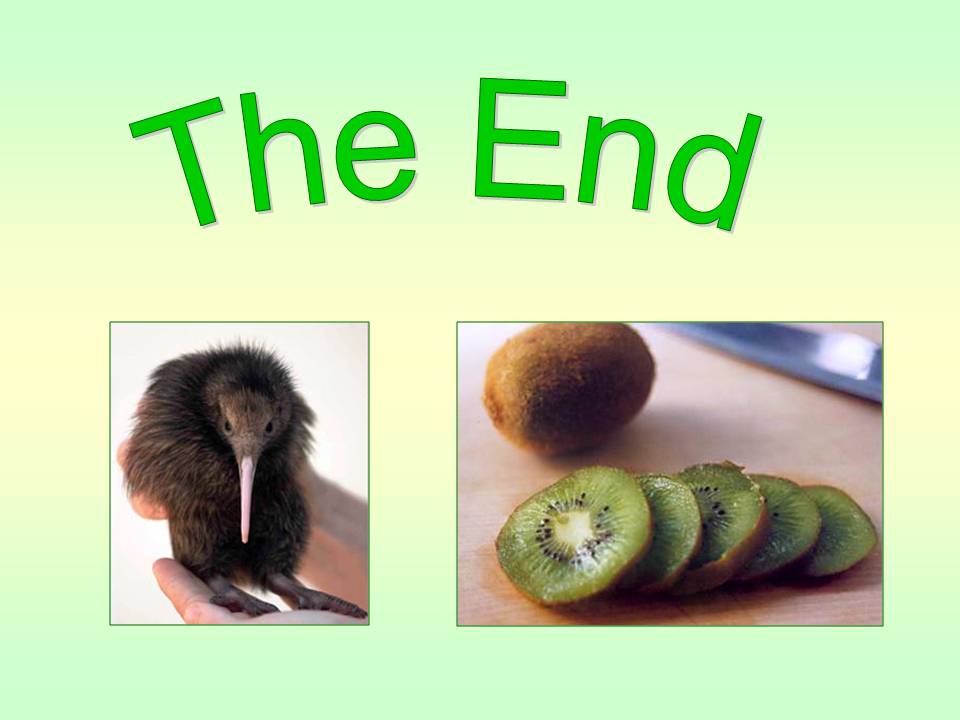- Головна
- Готові шкільні презентації
- Презентація на тему «New Zealand» (варіант 8)
Презентація на тему «New Zealand» (варіант 8)
202
Слайд #1
New
Zealand
Zealand
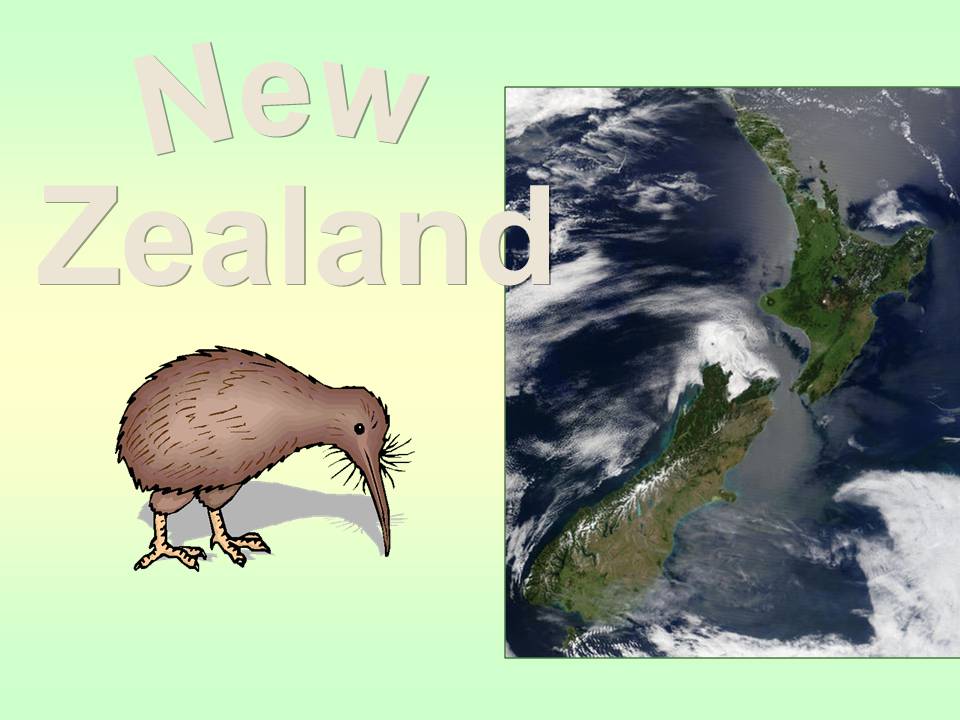
Слайд #2
FULL COUNTRY NAME : New Zealand
CAPITAL: Wellington
TOTAL AREA: 269,000 sq.km
POPULATION: 4,182,000 people
PEOPLE: 88% Europeans, 125 Maori and Polynesian
LANGUAGES: English and Maori
RELIGION: Predominantly Christian (81%)
HEAD OF STATE: Queen Elizabeth II represented by Governor-General
FORM OF GOVERNMENT: Constitutional monarchy
LONGEST RIVER: Waikato (425 km)
LARGEST LAKE: Taupo (606 km)
HIGHEST POINT: Mount Cook (3,754 m)
NATIONAL DAY: Waitangi Day , 6 February ( since 1840)
MAJOR INDUSTRIES: wood and paper products, wool, textile, iron, steel
CURRENCY: NZ dollar
NATIONAL SYMBOLS: Kiwi
NATIONAL ANTHEM: “God Defend New Zealand”
Some facts
CAPITAL: Wellington
TOTAL AREA: 269,000 sq.km
POPULATION: 4,182,000 people
PEOPLE: 88% Europeans, 125 Maori and Polynesian
LANGUAGES: English and Maori
RELIGION: Predominantly Christian (81%)
HEAD OF STATE: Queen Elizabeth II represented by Governor-General
FORM OF GOVERNMENT: Constitutional monarchy
LONGEST RIVER: Waikato (425 km)
LARGEST LAKE: Taupo (606 km)
HIGHEST POINT: Mount Cook (3,754 m)
NATIONAL DAY: Waitangi Day , 6 February ( since 1840)
MAJOR INDUSTRIES: wood and paper products, wool, textile, iron, steel
CURRENCY: NZ dollar
NATIONAL SYMBOLS: Kiwi
NATIONAL ANTHEM: “God Defend New Zealand”
Some facts
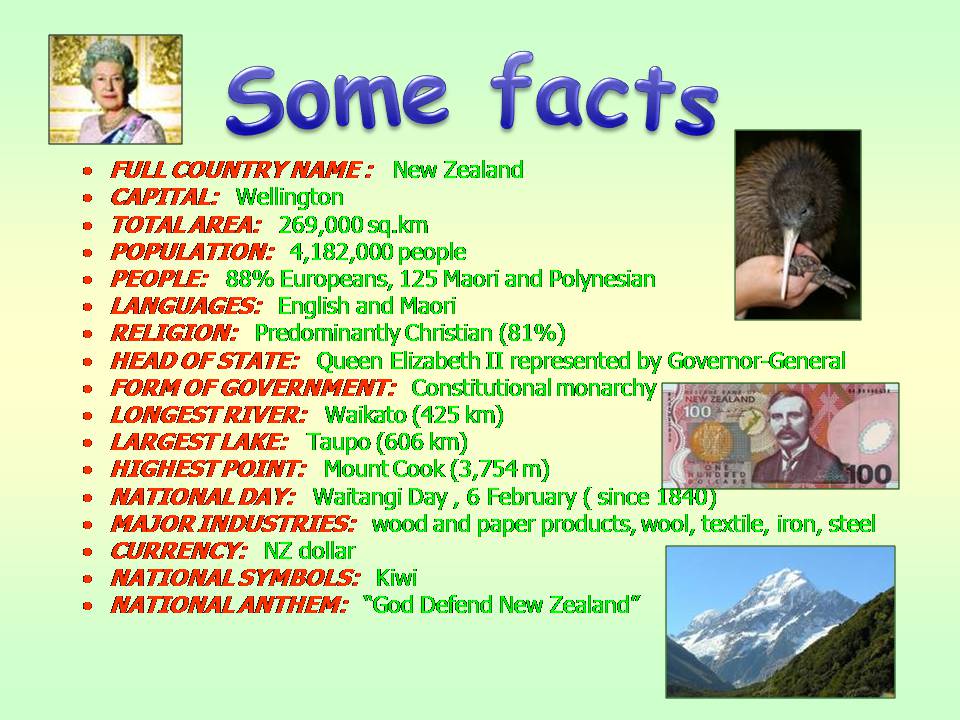
Слайд #3
New Zealand is a country in the south-western Pacific Ocean comprising two large islands – the North Island and the South Island – and numerous smaller islands, most notably Stewart Island/Rakiura and the Chatham Islands. In Māori, New Zealand has come to be known as Aotearoa, which is usually translated into English as The Land of the Long White Cloud. The Realm of New Zealand also includes the Cook Islands and Niue, which are self-governing but in free association; Tokelau; and the Ross Dependency (New Zealand's territorial claim in Antarctica). New Zealand is notable for its geographic isolation, being separated from Australia to the northwest by the Tasman Sea, approximately 2000 kilometres (1250 miles) across. Its closest neighbours to the north are New Caledonia and Tonga.
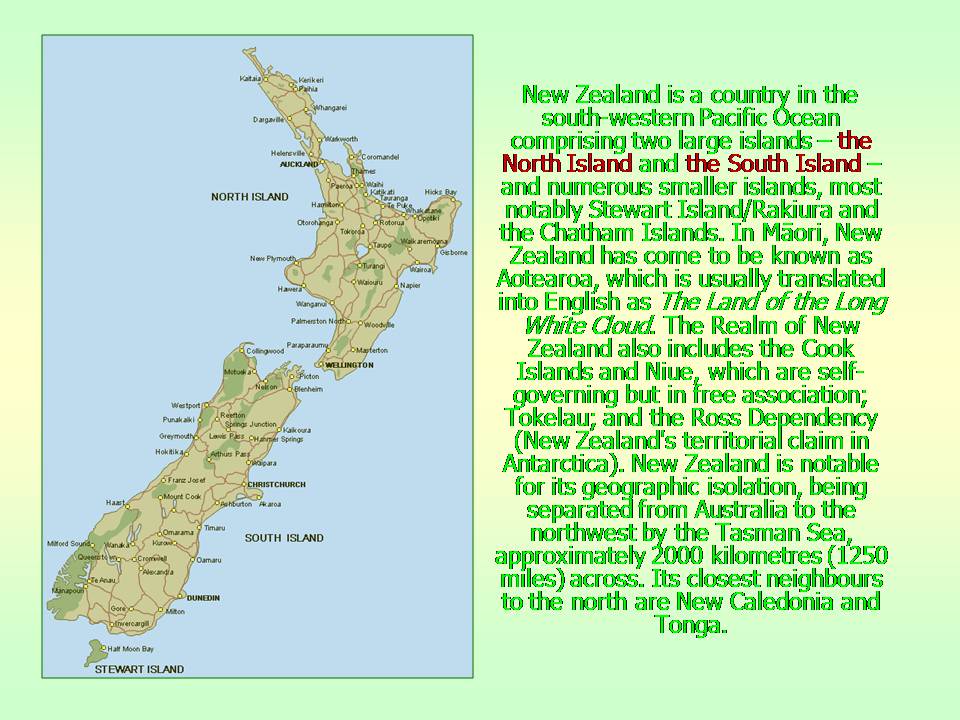
Слайд #4
The Flag of New Zealand is a defaced blue ensign with the Union Flag in the canton, and four red stars with white borders to the right. The stars represent the constellation of Crux, the Southern Cross, as seen from New Zealand. The flag proportion is 1:2 and the colours are Red, Blue and White. Proportion and colours are identical to the Union Flag.
Since 1990, some Māori have been using the red ensign less in favour of a new flag which lacks colonial connotations. Chosen through a competition, the Māori flag uses black to represent Te Korekore or potential being, white to represent Te Ao Marama or the physical world, red to represent Te Whei Ao, the realm of coming into being and the Koru, a curl representing the unfolding of new life.
Since 1990, some Māori have been using the red ensign less in favour of a new flag which lacks colonial connotations. Chosen through a competition, the Māori flag uses black to represent Te Korekore or potential being, white to represent Te Ao Marama or the physical world, red to represent Te Whei Ao, the realm of coming into being and the Koru, a curl representing the unfolding of new life.
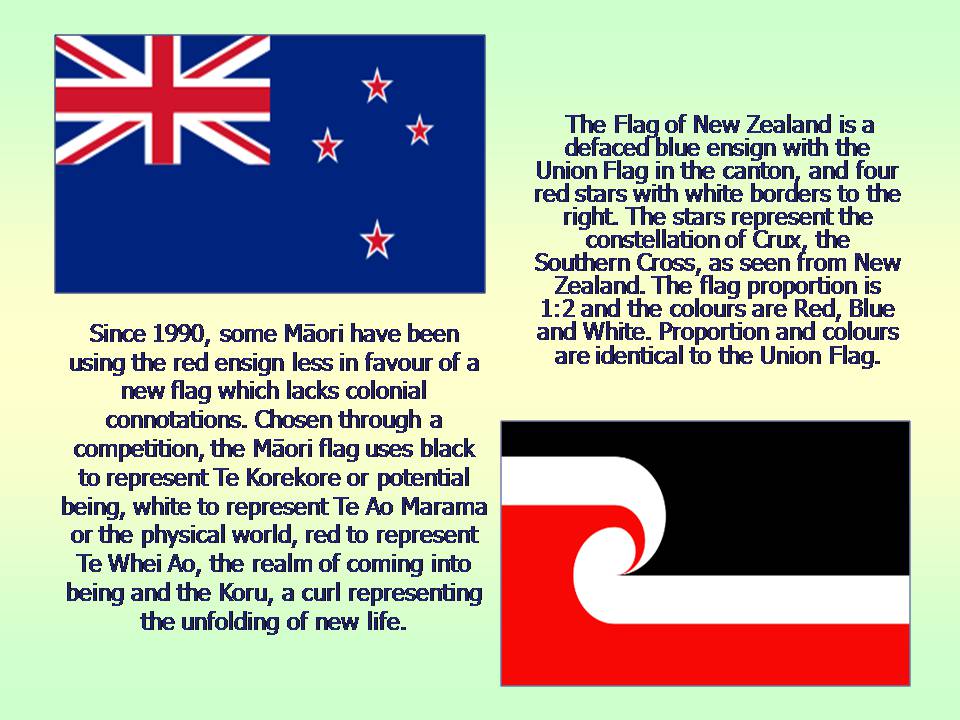
Слайд #5
Until 1911, New Zealand used the same national coat of arms as the United Kingdom. When New Zealand became a Dominion in 1907, it was decided that a new Coat of Arms was required, and a design competition was held. Since being granted its own arms in 1911, New Zealand's arms have remained similar to the current design, with minor changes in 1956. The shield is now supported by two figures, a blonde Pākehā (European) woman holding the New Zealand flag, and a Māori warrior holding a taiaha (Māori staff). The shield is topped with the St Edward's Crown, and beneath the shield are two silver fern leaves and a scroll bearing the words "New Zealand".
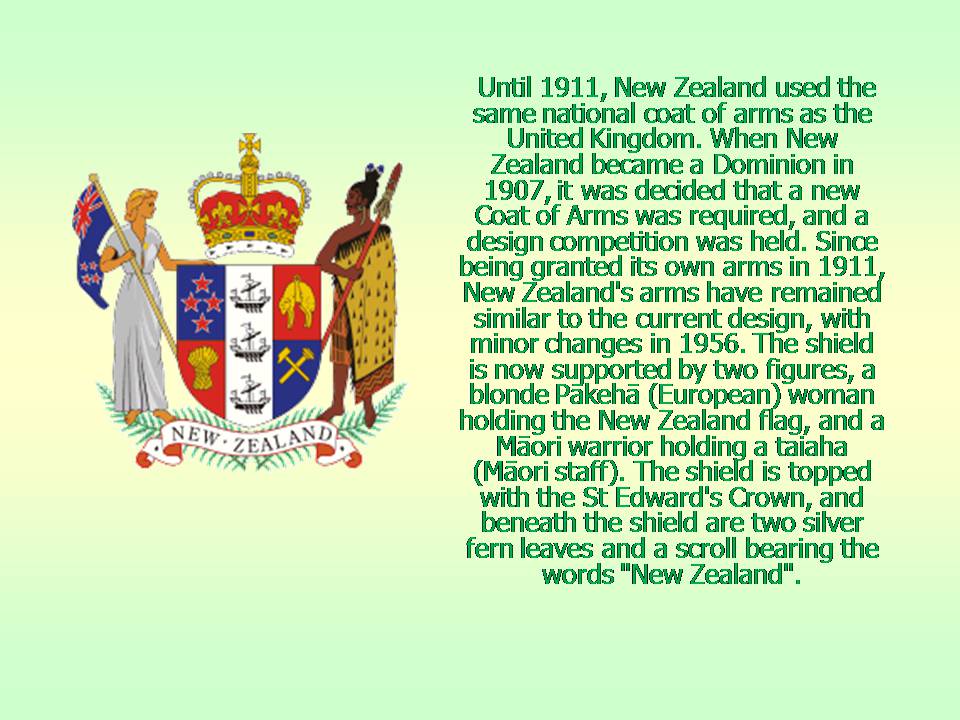
Слайд #6
The kiwi bird was named so for the sound of its chirp. This flightless bird, about the size of a domestic hen, has an extremely long beak and plumage more like hair than feathers. It has no tail, almost no wings. It weights about 2 kg. The female kiwi lays only one egg, but it is about 1/5th of her own weight. After laying it she leaves her husband to hatch the egg out. The New Zealand dollar is frequently called the Kiwi. The dollar coin features a kiwi bird on one side.
National Emblem
National Emblem
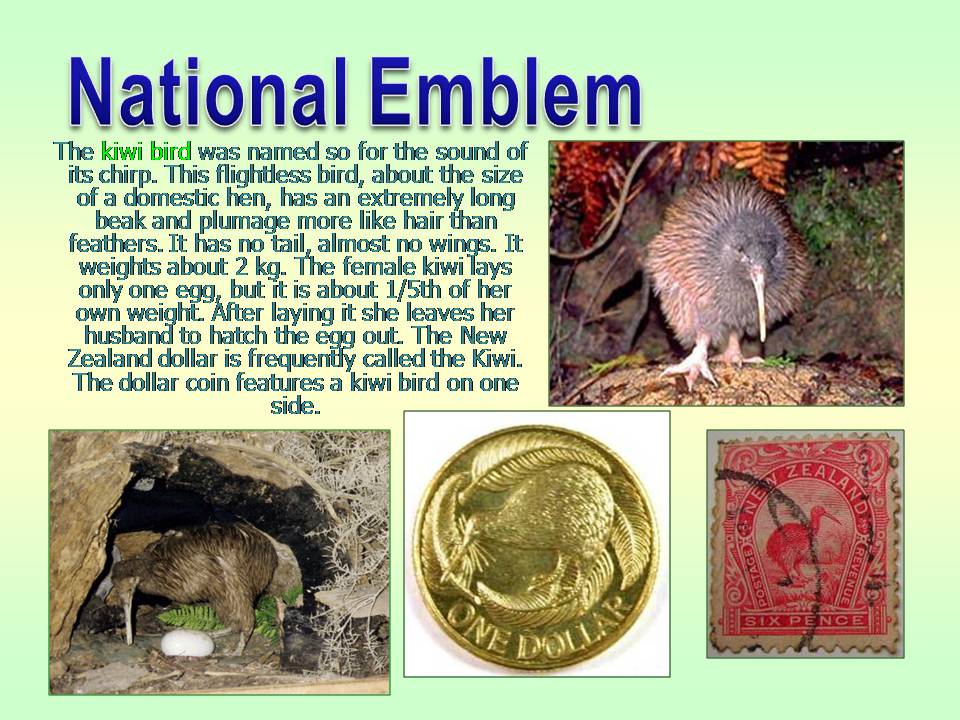
Слайд #7
The first Europeans known to have reached New Zealand were Dutch explorer Abel Janszoon Tasman and his crew in 1642. Any thoughts of a longer stay were thrown away when his attempt to land resulted in several of his crew being killed and eaten by Maori.
New Zealand is one of the most recently settled major land masses. The first settlers of New Zealand were Eastern Polynesians who came to New Zealand, probably in a series of migrations, sometime between around AD 800 and 1300. Over the next few centuries these settlers developed into a distinct culture now known as Māori.
No Europeans returned to New Zealand until British explorer James Cook's voyage of 1768. Following Cook, New Zealand was visited by numerous European and North American whaling, sealing and trading ships. They traded European food and goods, especially metal tools and weapons, for Māori timber, food, artifacts and water.
New Zealand is one of the most recently settled major land masses. The first settlers of New Zealand were Eastern Polynesians who came to New Zealand, probably in a series of migrations, sometime between around AD 800 and 1300. Over the next few centuries these settlers developed into a distinct culture now known as Māori.
No Europeans returned to New Zealand until British explorer James Cook's voyage of 1768. Following Cook, New Zealand was visited by numerous European and North American whaling, sealing and trading ships. They traded European food and goods, especially metal tools and weapons, for Māori timber, food, artifacts and water.
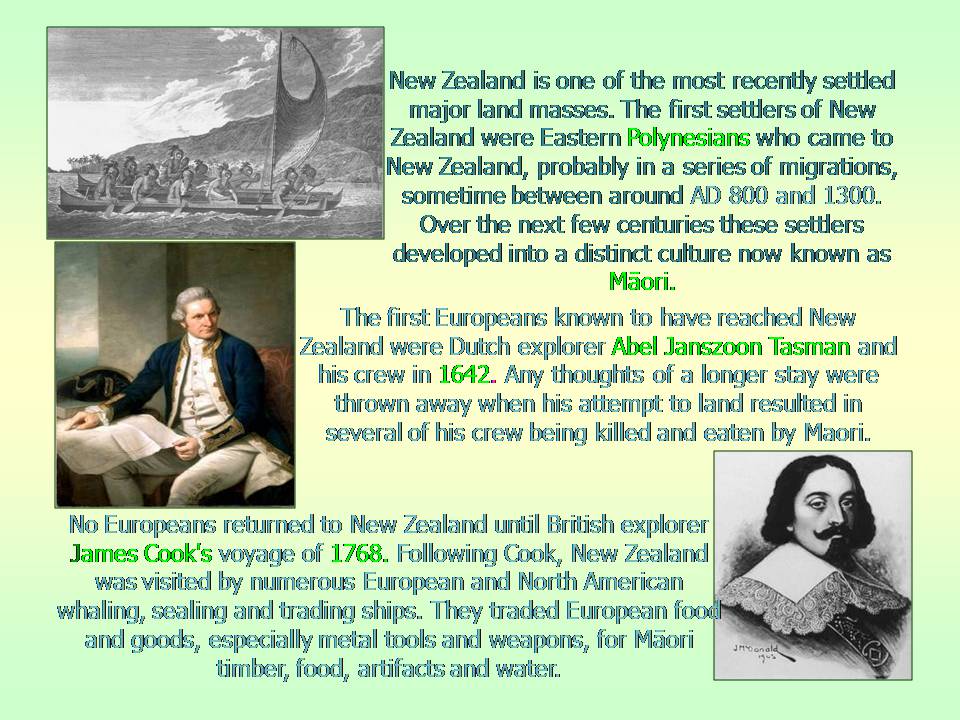
Слайд #8
New Zealand is a constitutional monarchy with a parliamentary democracy. Under the Royal Titles Act (1953), Queen Elizabeth II is Queen of New Zealand and is represented as head of state by the Governor-General Anand Satyanand . New Zealand is the only country in the world in which all the highest offices in the land have been occupied simultaneously by women: Queen Elizabeth II, Governor-General Dame Silvia Cartwright, Prime Minister Helen Clark, Speaker of the House of Representatives Margaret Wilson and Chief Justice Dame Sian Elias were all in office between March 2005 and August 2006.
Helen Clark
Margaret Wilson
Helen Clark
Margaret Wilson
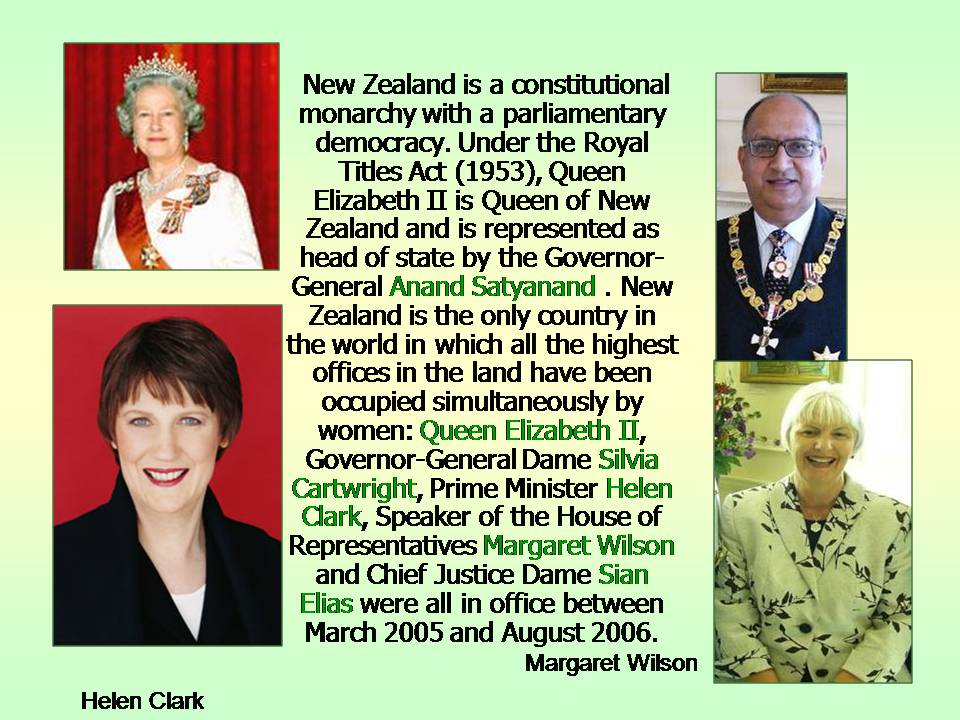
Слайд #9
The Maori people are the indigenous people of New Zealand. Maoritanga is the native language. It is believed that the Maori migrated from Polynesia in canoes about the 9th century to 13th century AD. The Maoris lived in tribes called ‘iwi'. They lived in villages and were fishermen, hunters and framers. The present Maori population has increased to about 250,000 and the Maori live in all parts of New Zealand, but predominately in the North Island where the climate is warmer.
Maori
Maori
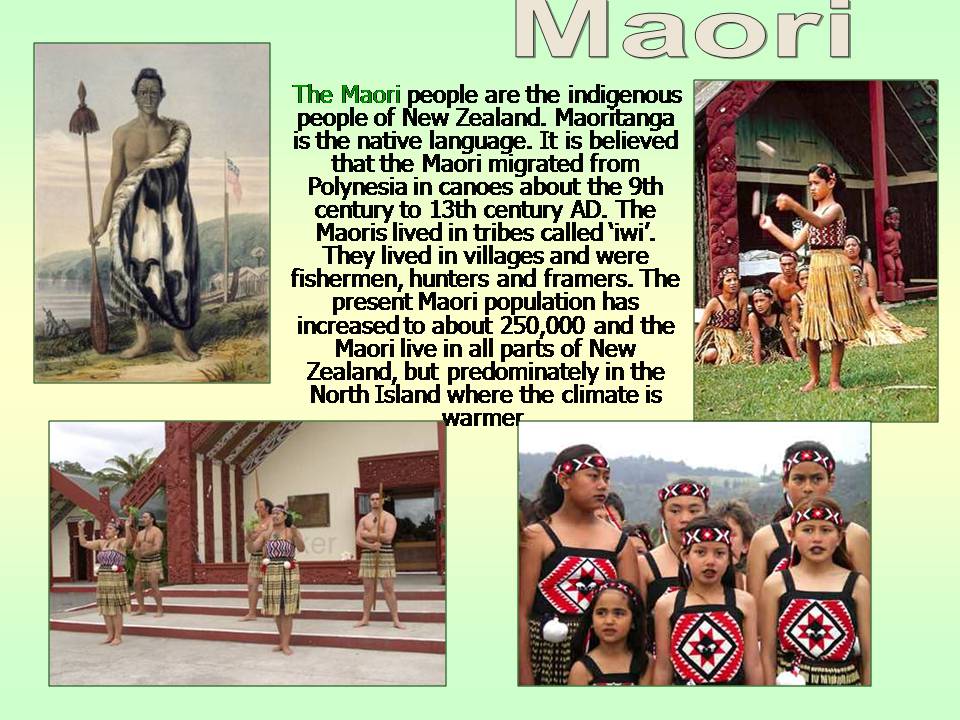
Слайд #10
Maori Art refers to all the traditional arts: whakairo (wood carving); kowhaiwhai (rafter patterns); ta moko (tattooing); waiata (songs and chants); haka (dance); whaikorero (oratory); waka ama (canoe racing), etc.
Wood Carving
A Fence
Tattoos
Waka taua
Maori Art
Wood Carving
A Fence
Tattoos
Waka taua
Maori Art
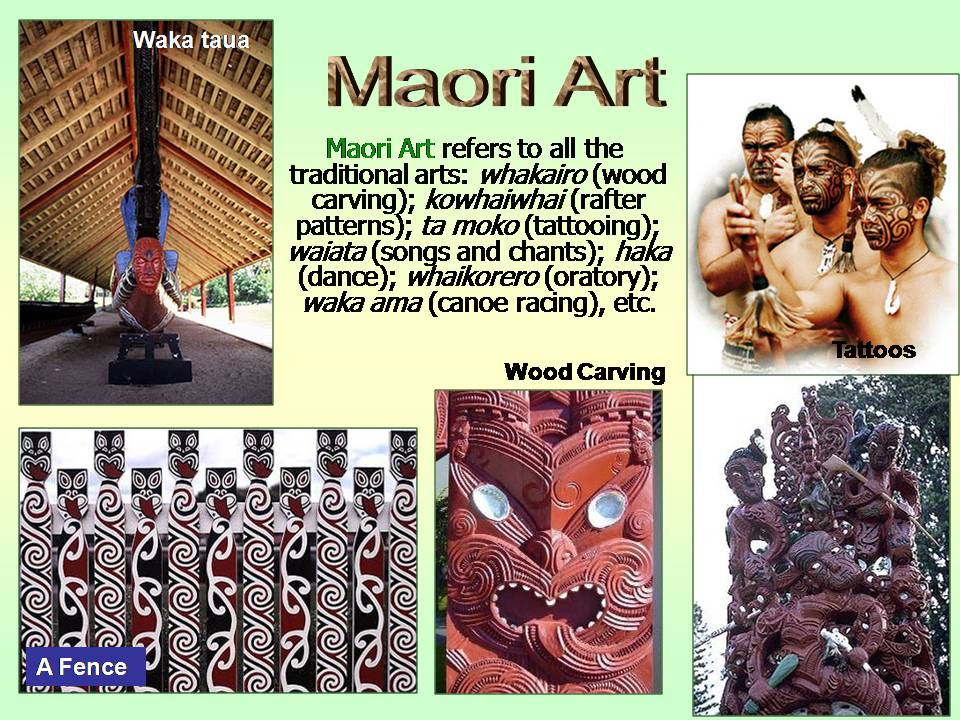
Слайд #11
The North Island is one of the two main islands of New Zealand. The island is 113,729 sq. km in area, making it the world's 14th-largest island. It has a population of 3,148,400. Several important cities are in the North Island: Auckland, and Wellington, the capital. Approximately 76% of New Zealand's population lives in the North Island.
North Island
North Island
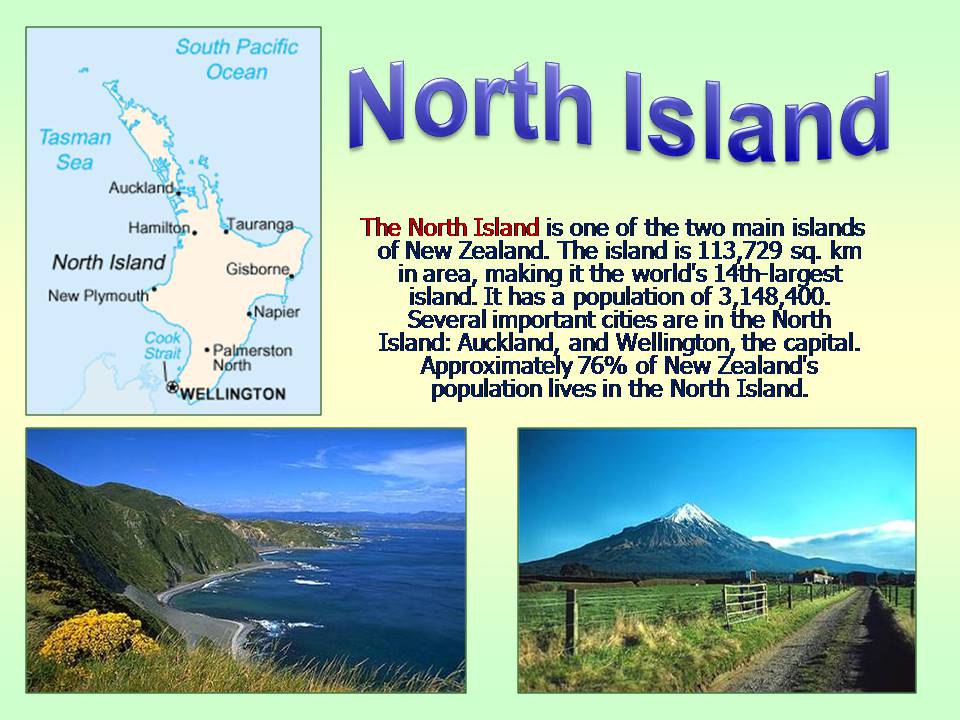
Слайд #12
Wellington is the capital of New Zealand, the country's second largest urban area and the most populous national capital in Oceania. The population is about 449,000 people. Wellington is New Zealand's political centre, housing Parliament and the head offices of all government ministries and departments, plus the bulk of the foreign diplomatic missions based in New Zealand.
Te Papa Museum
Wellington Parliament
Wellington
Te Papa Museum
Wellington Parliament
Wellington
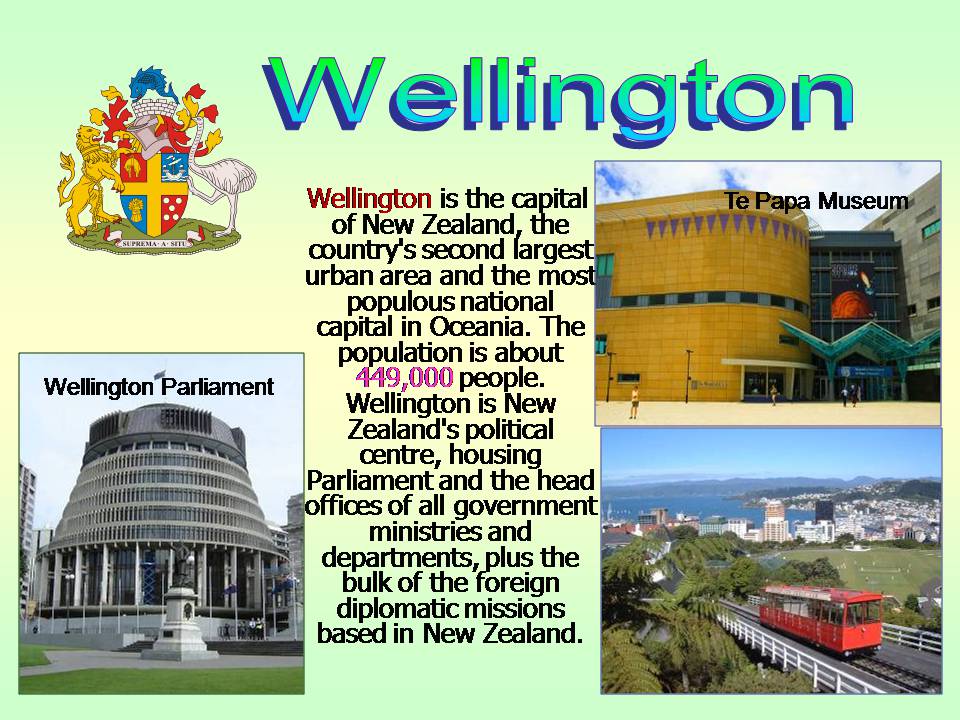
Слайд #13
Auckland is the largest urban area of the country. With over 1,260,900 people it has over a quarter of the country's population.
Skyline
Town Hall
Auckland Waterfront
Chancery
Auckland
Skyline
Town Hall
Auckland Waterfront
Chancery
Auckland
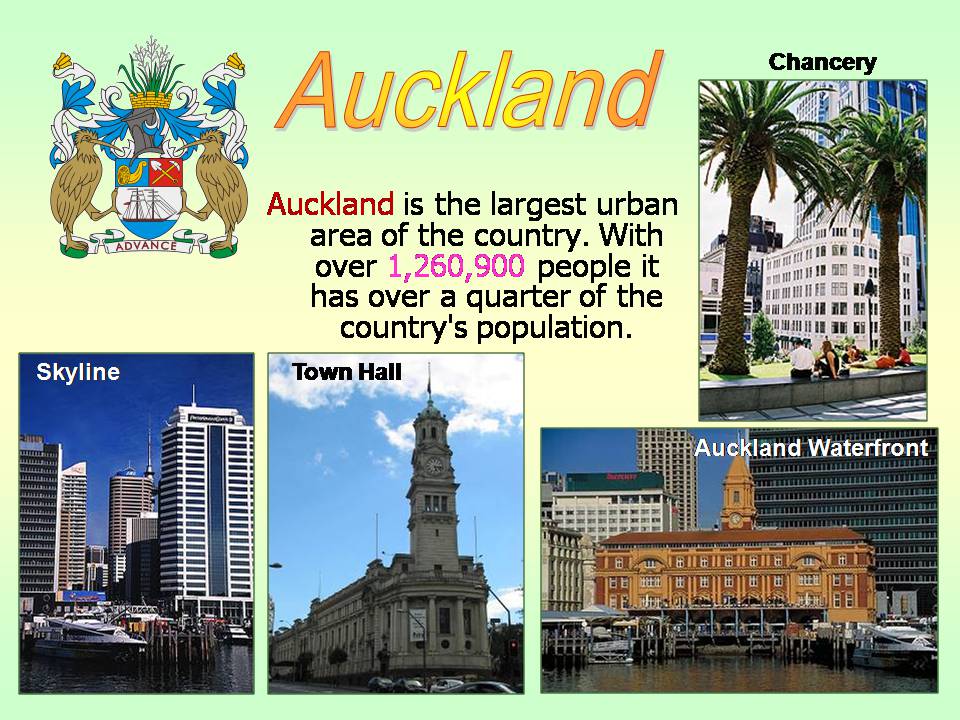
Слайд #14
Taupo is a small urban area in the centre of the North Island. It is the seat of the Taupo District Council. Taupo has a population of 22,300.Taupo is located at the north-east corner of Lake Taupo, and functions as a tourist centre, particularly in the summer, as it offers panoramic views over the lake and the volcanic mountains of Tongariro National Park to the south. One of New Zealand's most spectacular waterfalls, the Huka Falls is also close to the town.
Main Road
Lake
Huka Falls
Taupo
Main Road
Lake
Huka Falls
Taupo
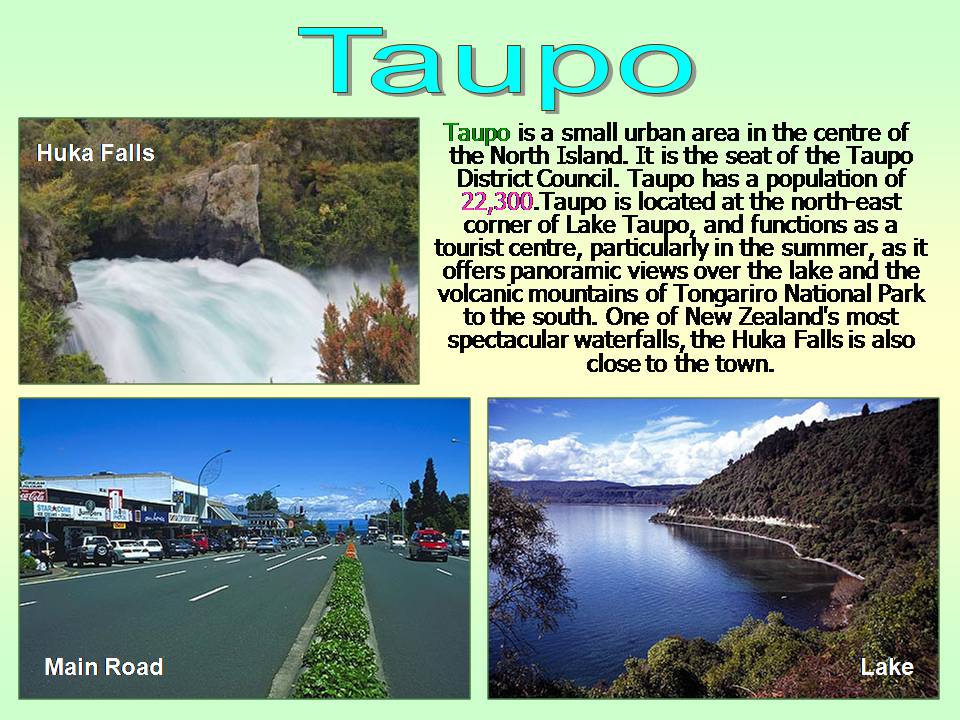
Слайд #15
The South Island is the larger of the two major islands of New Zealand. The South Island has an area of 151,215 sq. km, making it the world's 12th-largest island. It has a population of 991,100. Along its west coast runs the mountain chain of the Southern Alps with Mount Cook being the highest point, 3,754 m.
South Island
South Island
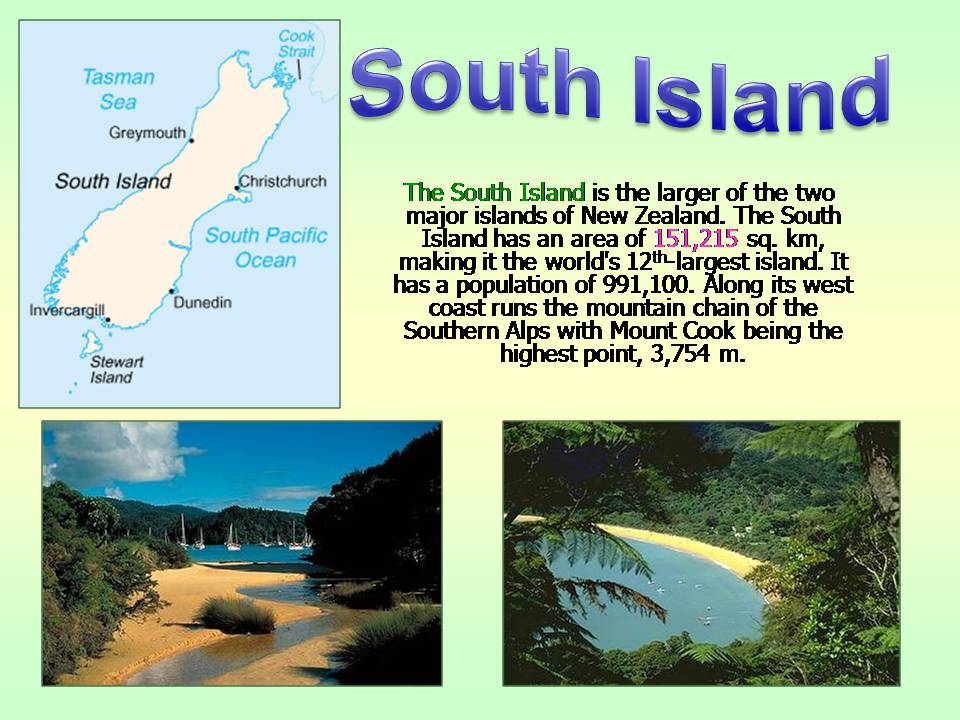
Слайд #16
Christchurch is the regional capital of Canterbury. The largest city in the South Island, it is also the second largest city and third largest urban area of New Zealand. The Population is about 367,700 people. The city is named after the Christ Church cathedral, which is itself named after Christ Church, a college at the University of Oxford, and the Cathedral of Oxford. The city was originally known as Christ Church, the written form consolidating by the 1880s.
College
Museum
Cathedral
Christchurch
College
Museum
Cathedral
Christchurch
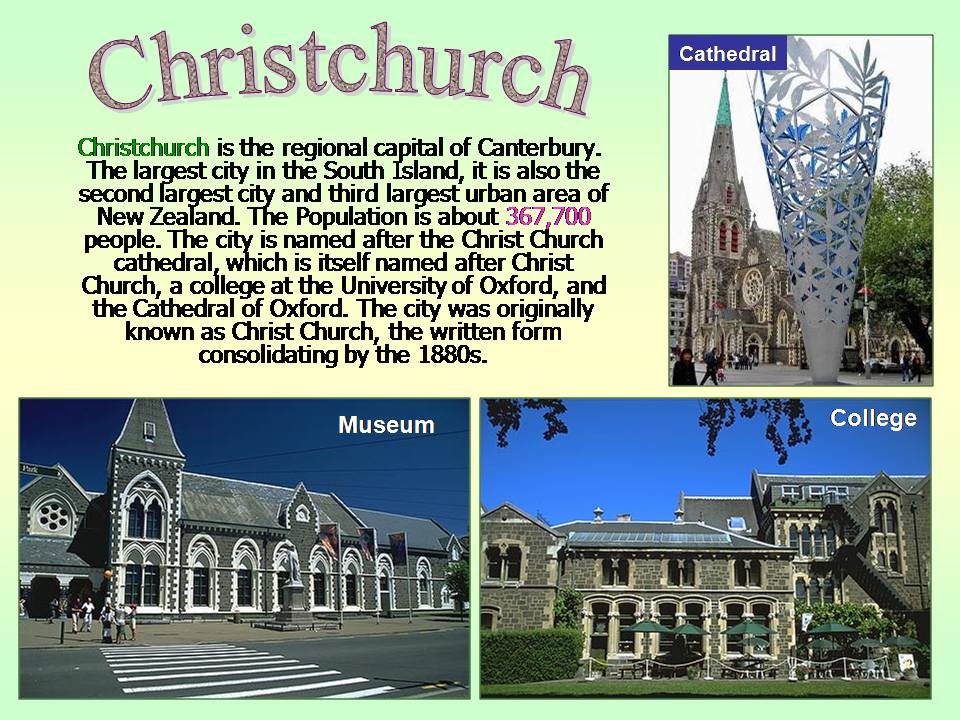
Слайд #17
Dunedin is the second-largest city in the South Island, and the principal city of the region of Otago. The population is about 114,700 people. It is New Zealand's fifth largest city in terms of population. For historical and cultural reasons, Dunedin is considered one of the country's four main centres. The city stands on the hills and valleys surrounding the head of Otago Harbour. The harbour and hills are the remnants of an extinct volcano. It is the home of the University of Otago.
Railway Station
Cathedral
Cathedral
Dunedin
Railway Station
Cathedral
Cathedral
Dunedin
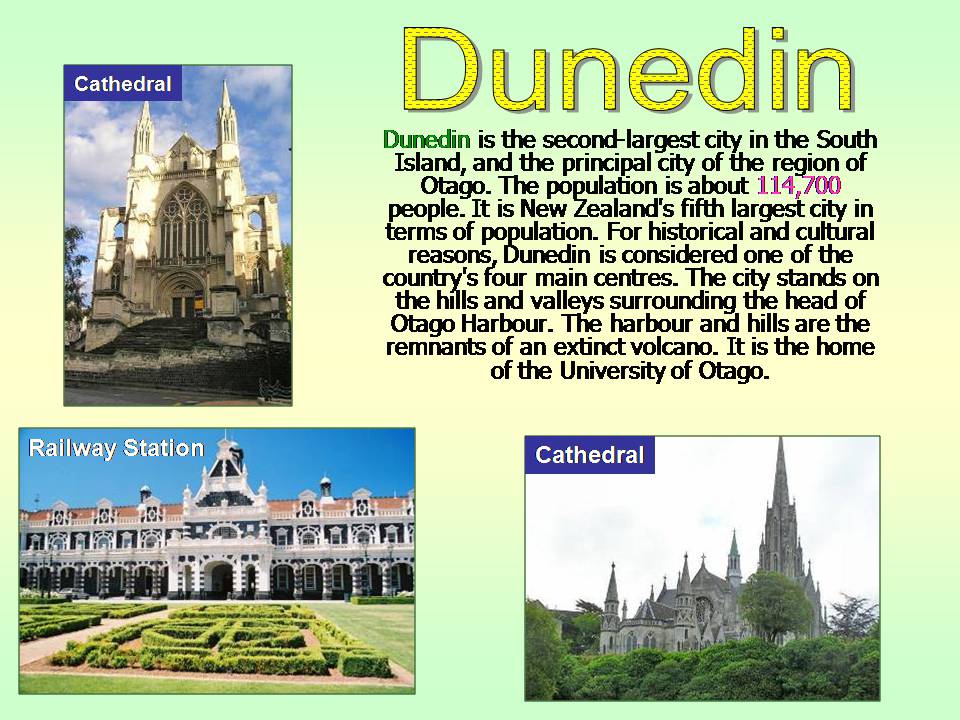
Слайд #18
New Zealand's 3rd largest island, Stewart Island is a very special place. The only town is Oban with population about 400 people. It is a heaven for native birds' life. The kiwi, rare in both the North and the South Island, is common over much of the island, particularly around beaches. The weather is changeable on the island. Tramping the many tracks, see kayaking, fishing, walking on the bird sanctuary, Ulva Island is some of the exiting things people can do on this island.
Oban
Stewart Island
Oban
Stewart Island
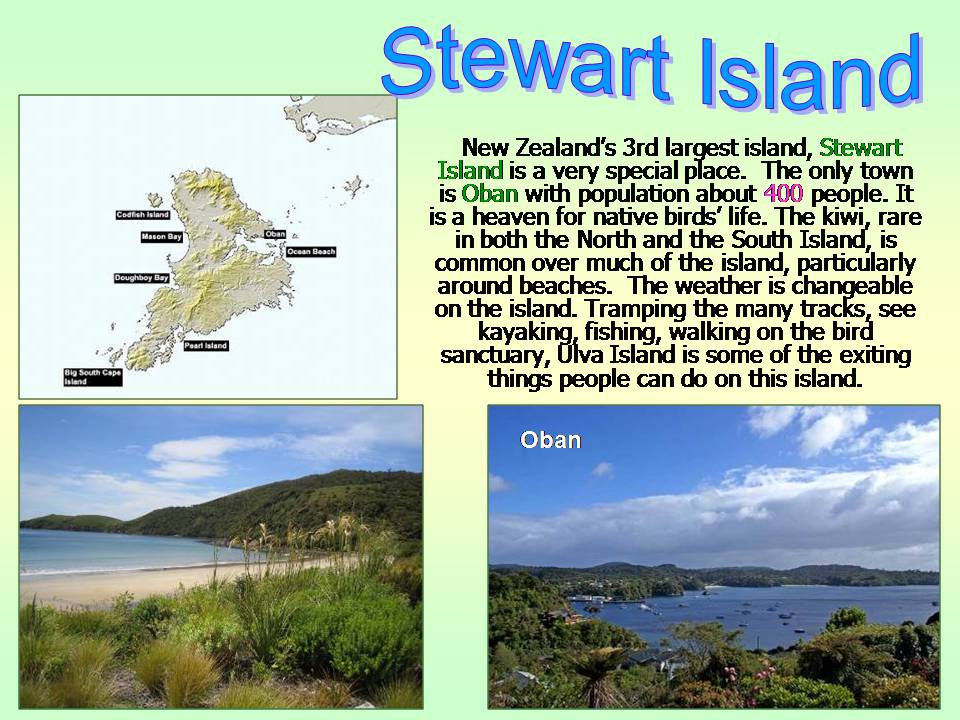
Слайд #19
There are some 70 species of birds found nowhere else in the world, more than a third of them are flightless, and almost a quarter of them nocturnal. Notable New Zealand birds include the Tui, Bellbird, Kiwi, Kakapo, Takahe, and Weka. New Zealand is also home to many seabirds including the Albatross, which has the longest wing span of any bird in the world. The most spectacular of all New Zealand birds was the Moa. Some Moa's reached heights of 15 feet, making them the tallest bird in the world.
Weka
Moa
Kakapo
Takahe
Birds
Weka
Moa
Kakapo
Takahe
Birds
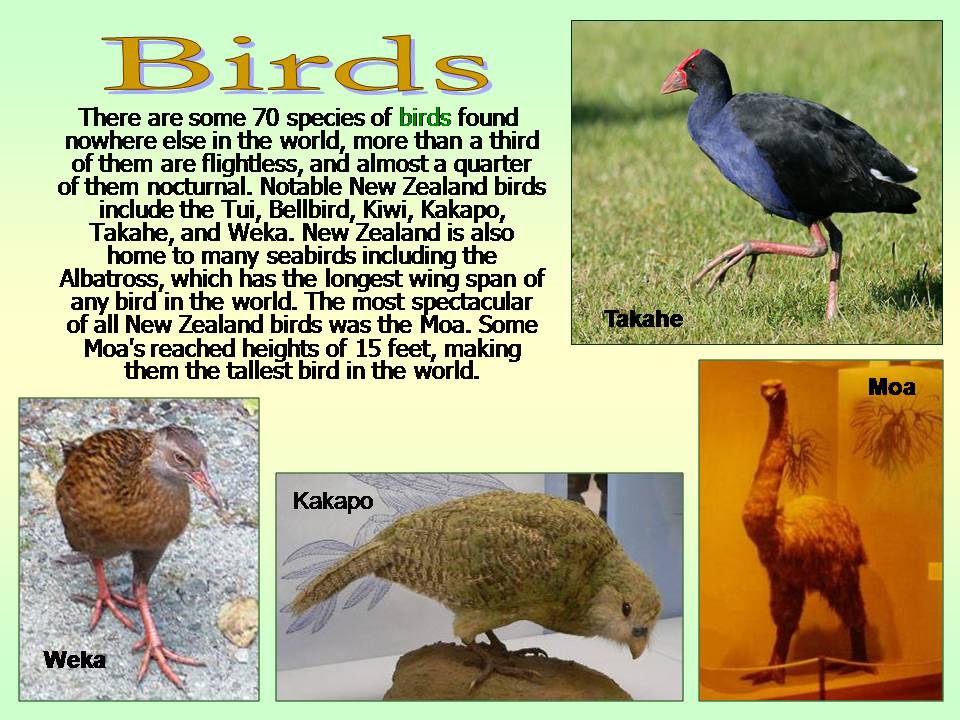
Слайд #20
New Zealand is one of the world's richest bio-diverse flora areas on earth. It is endemic and its extent is enormous. Native trees include Rimu, Totara, Matai, Kahikatea, Rata, Tawa and many species of ferns including some giant tree ferns. Other notable trees include the Cabbage Tree, the Nikau Palm which is New Zealand's only palm tree, and the Giant Kauri, which hold the record for the greatest timber volume of any tree. One of the most noticeable plants is the Pohutukawa which detonates with brilliant red flowers around December.
Cabbage Tree
Nikau Palm
Pohutukawa
Fern
Rata
Plants
Cabbage Tree
Nikau Palm
Pohutukawa
Fern
Rata
Plants
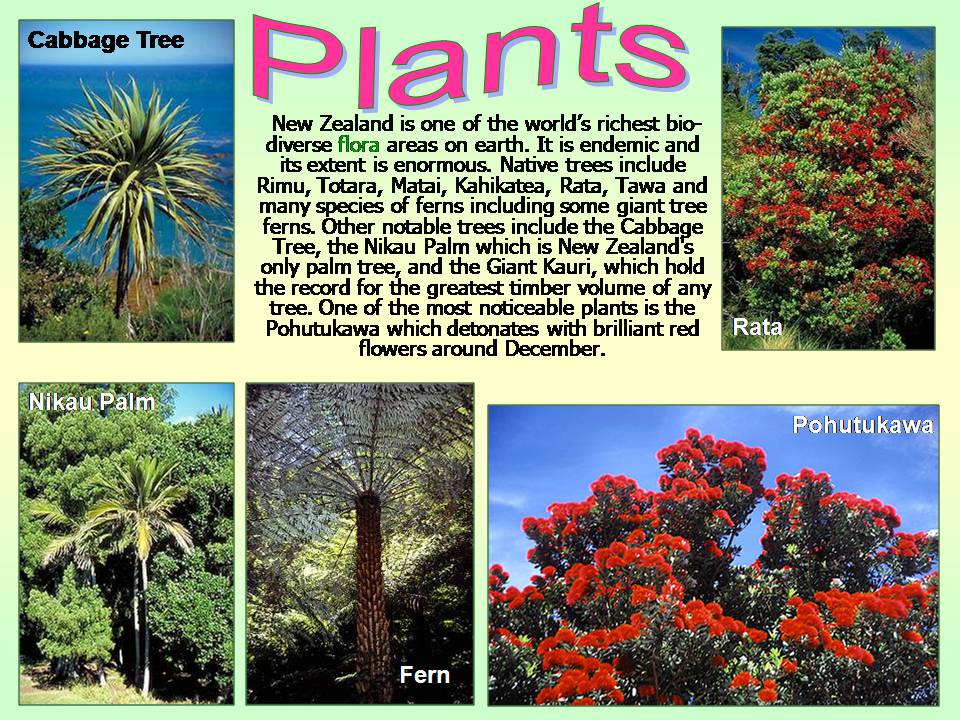
Слайд #21
With the exception of two species of bat, no indigenous mammals are native to New Zealand. Wild mammals include deer, goats, pigs, rabbits, weasels, ferrets. Marine mammals are dolphins, seals and whales. New Zealand contains no snakes and has only one poisonous spider called the Katipo. Other insects include the Weta one species of which may grow as large as a house mouse and is the heaviest insect in the world. New Zealand's most unigue animal is the Tuatara, which is a lizard-like reptile that predates the Dinosaur and is considered a living fossil.
Katipo
Tuatara
Animals
Katipo
Tuatara
Animals
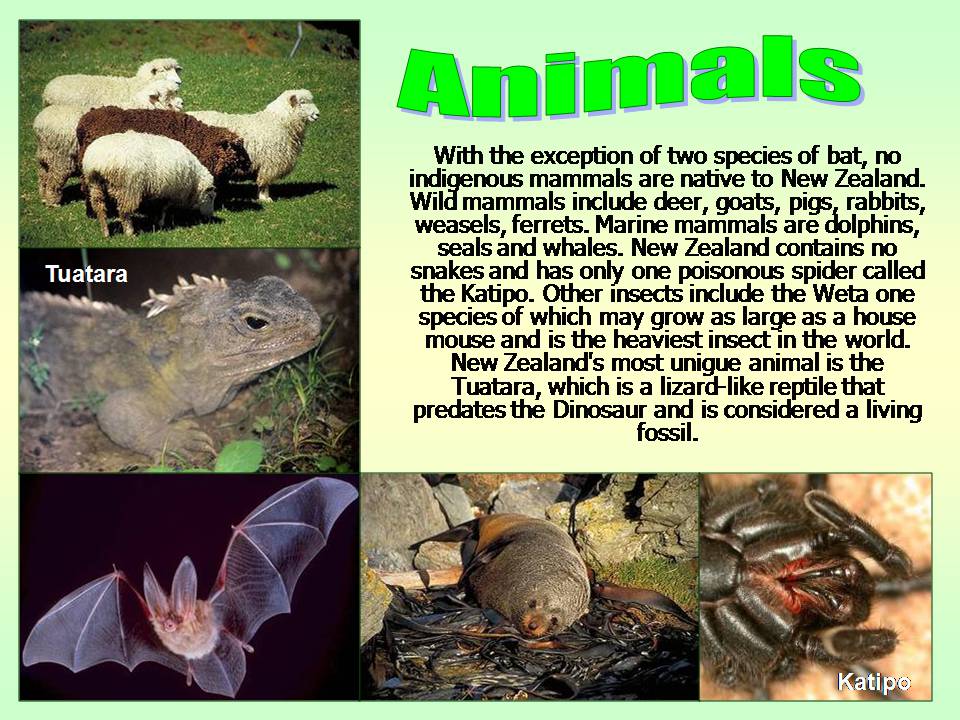
Слайд #22
Abel Tasman NP
Mount Aspiring NP
Whanganui NP
Paparoa NP
National Parks
Mount Aspiring NP
Whanganui NP
Paparoa NP
National Parks
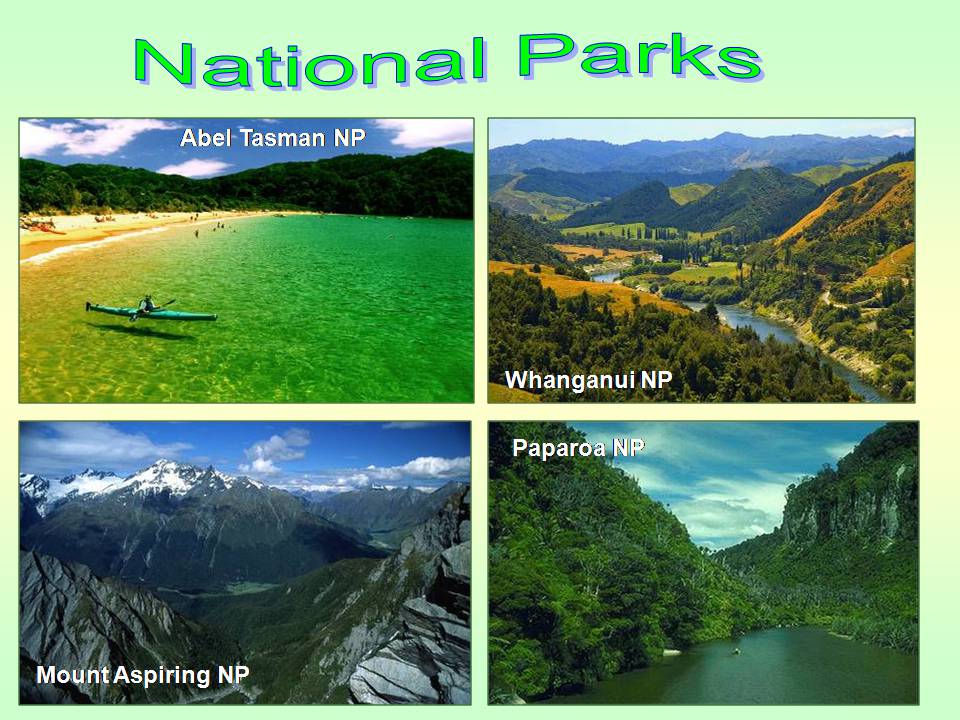
Слайд #23
The End
